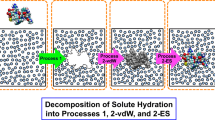Abstract
A recently introduced modified hydration shell hydrogen bond model for rationalizing the thermodynamic consequences of hydrophobic hydration is adapted for use with heavy water. The required adjustment of parameters employs the assumption that breaking hydrogen bonds in water-d2 involves a greater enthalpy change and a larger entropy increase than bond breaking in ordinary water. It also makes some use of information derived from studies of gas solubilities in the two solvents, although a review of the data leads to serious questions about the reliability of results obtained in this way. The model permits calculations of hydrogen bonding contributions to the changes, ΔG ot , ΔH ot , ΔS ot , and ΔC op,t , for transfer of nonpolar solutes from water to water-d2 and implies that such data should show regular trends. Although some of the numerical results depend strongly on the values chosen for the parameters, the pattern defined by these trends is nearly independent of parameters. Predicted values of ΔC op,t are large and positive for all nonpolar solutes, while ΔS ot is expected to be negative near 0°C, becoming progressively less negative on warming and eventually positive. Both of these quantities should be proportional to the molecular surface area of the solute. Analogous predictions regarding ΔG ot and ΔH ot can also be made, but only if it is permissible to neglect possible contributions to these quantities from van der Waals interactions.
Similar content being viewed by others
References
S. J. Gill,J. Chem. Thermodyn. 20, 1361 (1988).
P. Privalov and S. J. Gill,Adv. Protein Chem. 40, 191 (1988);Pure and Appl. Chem. 61, 1097 (1989).
S. J. Gill, S. F. Dec, G. Olofsson, and I. Wadsö,J. Phys. Chem. 89, 3758 (1985).
N. Muller,J. Solution Chem. 17, 661 (1988).
N. Muller,Accounts Chem. Research 23, 23 (1990).
G. C. Kresheck, H. Schneider, and H. A. Scheraga,J. Phys. Chem. 69, 3132 (1965).
A. Ben-Naim,J. Chem. Phys. 52, 1512 (1965).
A. Ben-Naim, J. Wilf, and M. Yaacobi,J. Phys. Chem. 77, 95 (1973).
W. Y. Wen and J. A. Muccitelli,J. Solution Chem. 8, 225 (1979).
B. A. Cosgrove and J. Walkley,J. Chromatography 216, 161 (1981).
R. Crovetto, R. Fernandez-Prini, and M. L. Japas,J. Chem. Phys. 76, 1077 (1982).
A. Ben-Naim,J. Phys. Chem. 79, 1268 (1975).
Y. Marcus and A. Ben-Naim,J. Chem. Phys. 83, 4744 (1985).
E. M. Arnett and D. R. McKelvey, inSolute-Solvent Interactions J. F. Coetzee and C. D. Ritchie, eds., (Dekker, New York, 1969), Chap. 6.
G. Jansco and W. A. Van Hook,Chem. Revs. 74, 689 (1974).
E. Wilhelm, R. Battino, and R. J. Wilcock,Chem. Revs. 77, 219 (1977).
S. F. Dec and S. J. Gill,J. Solution Chem. 14, 827 (1985);
14, 416 (1985).
B. B. Benson and D. Krause, Jr.,J. Chem. Phys. 64, 689 (1976).
D. Krause, Jr. and B. B. Benson,J. Solution Chem. 18, 823 (1989).
N. Muller,J. Phys. Chem. 94, 3856 (1990).
G. Némethy and H. A. Scheraga,J. Chem. Phys. 41, 680 (1964).
J. Kirshenbaum,Physical Properties and Analysis of Heavy Water (McGraw-Hill, New York, 1951), p. 31.
W. A. P. Luck, inPhysico-Chemical Processes in Mixed Aqueous Solvents, F. Franks, ed., (Elsevier, New York, 1967), p. 12.
G. E. Walrafen, inHydrogen-Bonded Solvent Systems, A. K. Covington and P. Jones, eds., (Taylor and Francis, London, 1968), p. 25.
J. Kirshenbaum,Physical Properties and Analysis of Heavy Water (McGraw-Hill, New York, 1951), Ref. 22 J. Kirshenbaum,Physical Properties and Analysis of Heavy Water (McGraw-Hill, New York, 1951), p. 32.
Author information
Authors and Affiliations
Rights and permissions
About this article
Cite this article
Muller, N. Model calculations of changes of thermodynamic variables for the transfer of nonpolar solutes from water to water-d2 . J Solution Chem 20, 669–680 (1991). https://doi.org/10.1007/BF00650715
Received:
Revised:
Issue Date:
DOI: https://doi.org/10.1007/BF00650715




